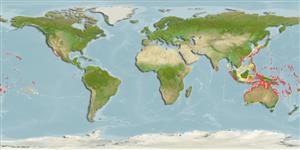Environment: milieu / climate zone / depth range / distribution range
Ecologie
marien rifbewoner; diepte 4 - 40 m (Ref. 90102), usually 27 - 30 m (Ref. 9710). Tropical
Western Pacific: southern Japan to the Great Barrier Reef, east to Pitcairn, west to Western Australia.
Grootte / Gewicht / Leeftijd
Maturity: Lm ? range ? - ? cm
Max length : 15.0 cm TL mannelijk / geslacht onbekend; (Ref. 48636)
Dorsale stekels (totaal) : 5; Dorsale zachte stralen (totaal) : 21; Anale stekels: 1; Anale zachte stralen: 16 - 17. Recognized by the double lines of dashes over the back (Ref. 48636). Lower two-thirds of body whitish with 8 narrow red bars, each containing 2 dark spots (black or darker red), one at of bar and one at level of lower third of body. A small dark red to black spot on abdomen above base of pelvic fins. Spinous portion of dorsal fin cream with a broad oblique black bar (except posteriorly). Scales on opercle cycloid (Ref 42740).
Mainly occurs at moderate depth on open rubble reef flats, but occasionally more shallow on outer reef habitats (Ref. 48636). Usually on rubble or sand near coral reefs (Ref. 42740) solitary or forms small groups (Ref. 90102).
Levenscyclus en paargedrag
Maturiteit | Voortplanting | Paaien | Eieren | Fecunditeit | Larven
Randall, J.E., G.R. Allen and R.C. Steene, 1990. Fishes of the Great Barrier Reef and Coral Sea. University of Hawaii Press, Honolulu, Hawaii. 506 p. (Ref. 2334)
Status op de Rode Lijst van het IUCN (Ref. 130435: Version 2024-1)
Gevaar voor de mens
Harmless
Gebruik door de mens
Visserij: van geen belang
Tools
Speciale rapporten
Download XML
Internetbronnen
Estimates based on models
Preferred temperature (Ref.
123201): 24.2 - 28.5, mean 26.9 °C (based on 46 cells).
Fylogenetische diversiteitsindex (Ref.
82804): PD
50 = 0.5000 [Uniqueness, from 0.5 = low to 2.0 = high].
Bayesian length-weight: a=0.00692 (0.00314 - 0.01524), b=3.06 (2.88 - 3.24), in cm total length, based on LWR estimates for this Genus-body shape (Ref.
93245).
Trofisch niveau (Ref.
69278): 3.5 ±0.4 se; based on size and trophs of closest relatives
Weerstandsvermogen (Ref.
120179): Hoog, minimale populatieverdubbelingstijd minder dan 15 maanden (Preliminary K or Fecundity.).
Fishing Vulnerability (Ref.
59153): Low vulnerability (10 of 100).
Nutrients (Ref.
124155): Calcium = 110 [59, 172] mg/100g; Iron = 0.719 [0.451, 1.168] mg/100g; Protein = 18.1 [15.8, 20.0] %; Omega3 = 0.102 [0.062, 0.174] g/100g; Selenium = 29.9 [15.5, 58.9] μg/100g; VitaminA = 102 [36, 283] μg/100g; Zinc = 1.64 [1.12, 2.31] mg/100g (wet weight);
